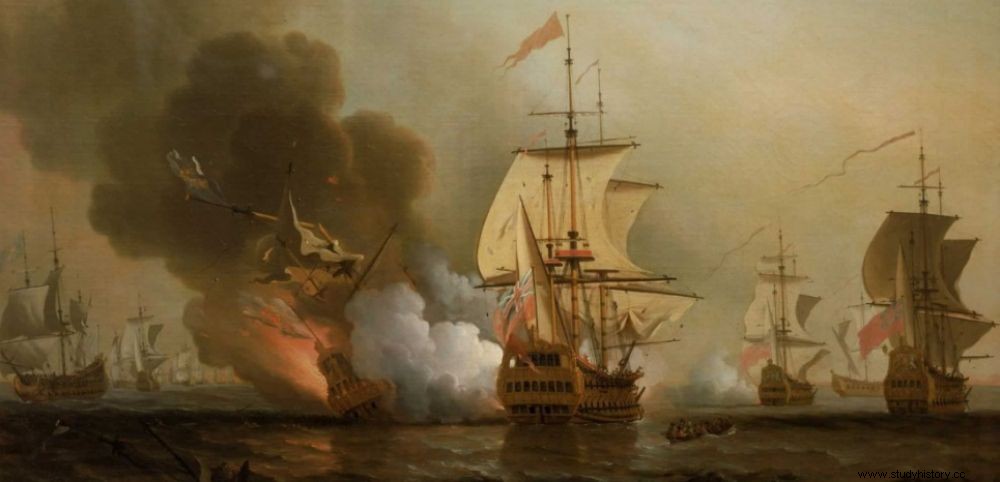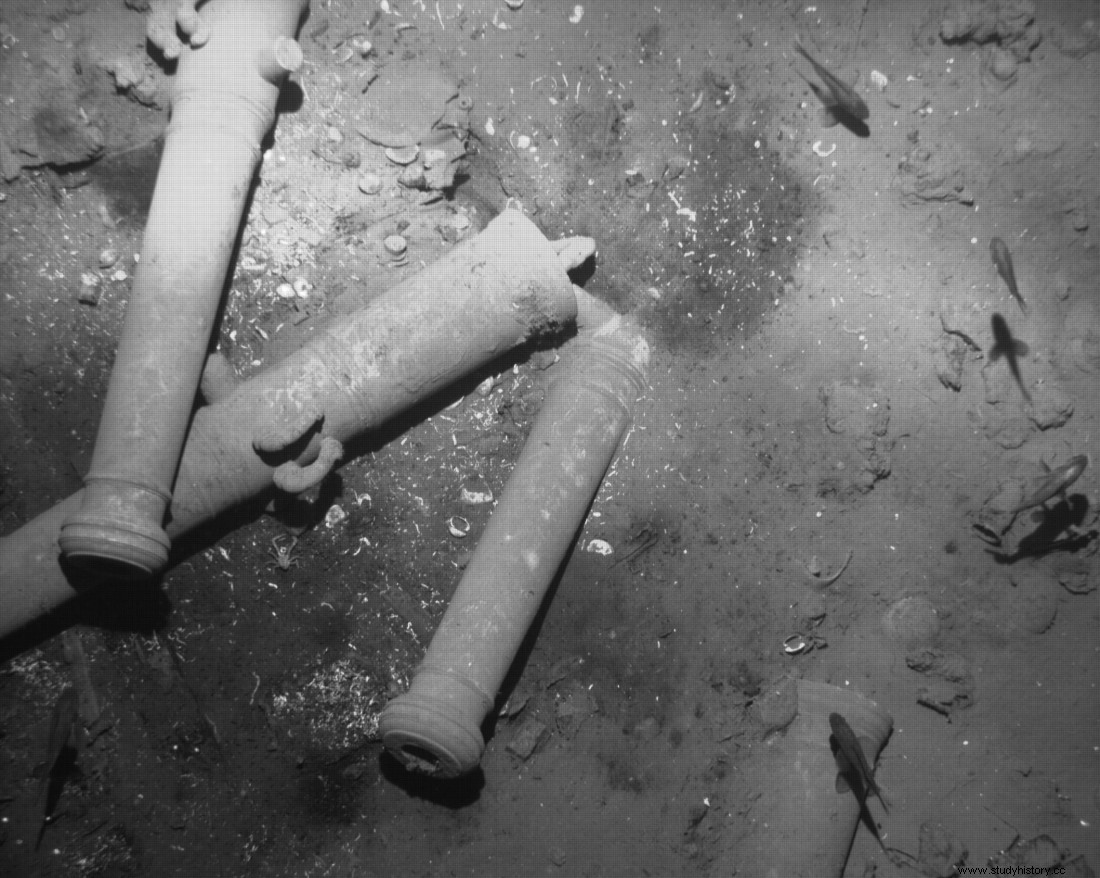 The ship "San José" during a naval battle off Cartagena, in June 1708. She was sunk with his treasure during this battle.
The ship "San José" during a naval battle off Cartagena, in June 1708. She was sunk with his treasure during this battle. DISCOVERY. It's with a simple tweet that the President of the Republic of Colombia, Juan Manuel Santos, announced on Friday December 4 the discovery of the much sought-after wreck of the San José , 307 years after its sinking, the holds swelled with 200 tons of gold, silver and emeralds.
It was in June 1708 that the Spanish ship was attacked and sunk by a British warship off the coast of Cartagena, in the territorial waters of Colombia where it now rests at a depth of more than 300m... According to the most accurate estimates low, the value of the load thus sent by the fund would reach 3 billion euros!

Underwater photo of the guns of the San José, Spanish galleon sunk off the coast of Cartagena (Colombia), projected during the press conference on Saturday, December 5, 2015.© HO/CULTURE MINISTRY/AFP
The exceptional discovery would have taken place on November 27, thanks to the combined efforts of a team made up of researchers from the Colombian Institute of Anthropology and History (ICANH) led by Ernesto Montenegro, the Navy of Colombia (DIMAR) and the international specialists. Without wanting to give details as to the actual location of the wreck, Colombian President Juan Manuel Santos confirmed during a press conference that the ship was between the Rosario archipelago and the Baru peninsula, off the coast of the city of Cartagena. Only a few photos of cannons and sonar images of the wreck taken from the Colombian vessel Malpelo were projected.
A treasury to finance the Wars of Spanish Succession
It was to finance the Wars of Spanish Succession (1701 to 1714) - a conflict which opposed several European powers, concerning the succession of the Spanish throne which remained without an heir - that the San Jose, commanded by Admiral José Fernandez de Santillan, had sailed from the American colonies of Peru. With, on board, an important treasure destined for Philippe V, the French king chosen by Louis XIV to sit on the Hispanic throne. He then headed for Cartagena, to then go to Havana (Cuba) where he was to stop like all the "golden fleets" before taking the road to Spain in a convoy (read Sciences and Future # 779, January 2012). But no less than four British ships - the Kingston , the Portland , the Vulture and Shipping - lay in ambush and attacked the convoy in a battle now known as the Battle of Baru on 7–8 June 1708. Commanded by Commodore Charles Wager, the Expedition sent the San José bottom, killing 578 passengers and crew. Only 11 sailors are believed to have survived.
This is not the first time that the discovery of the San José has been announced. Indeed, the American society of treasure hunters Sea Search Armada (SSA), a long-time partner of the Colombian government, had already reported the first location of the wreckage in... 1981! But a legal dispute having opposed for very long years the stakeholders concerning the sharing of the fabulous loot, the Colombian government had finally settled by declaring the ship and its contents state properties. What a court in Washington (United States) had confirmed in 2011.
A museum in Colombia to exhibit these riches
Now that it is officially "located", the research will use the most sophisticated technologies to probe the wreckage, such as submersible vehicles or ROV robots (see Sciences et Avenir, n°789, Nov. 2012 ). The scientific study and recovery of the precious cargo must indeed be done with a ship lying on its side... in unstable equilibrium at the edge of an underwater trench! That is to say beyond the limits of human diving, located around 100m for great professionals. A museum should be built in Colombia to display the riches brought to the surface.
It remains to be seen whether Spain, the historic recipient of the fabulous cargo, or Peru, the country of origin of the gold, or even Bolivia, to which the silver mines of Potosi belonged, will not claim their share of the booty!
The "San José"
This Spanish galleon, a powerful warship of over a thousand tons, was built near San Sebastian, Spain, in 1698, together with another sister ship, the San Joaquim . In 1708, she set sail from the port of Cartagena, together with other ships responsible for protecting the merchant ships of the imperial fleet, including the Santa Cruz , Nuestra Senhora de la Concepcion , Nuestra Senora del Carmen …and even two French ships, the Mieta and the Holy Spirit. All of these ships actually found themselves at the heart of the Battle of Baru which took place off Cartagena between June 7 and 8, 1708 and where the San was sunk in just a few seconds. Jose , -"not even time for a prayer" , we read in documents of the time kept in Seville (Spain).
